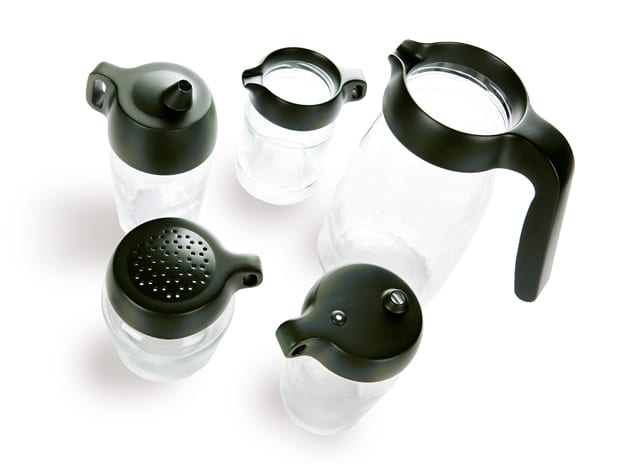
words William Wiles
Designers exist to bring things into being. But what if they don’t want to add to consumer society’s surplus of stuff? William Wiles explores a loophole.
The problem has occurred to most designers at one time or another. Designers are mostly conscientious people, and understand that the environmental crisis is the result of over-consumption. But their role in society is to design new products, and to indirectly encourage people to buy those products, feeding the consumerist beast.
But many designers have found a loophole in the consumer system – the parasite product. Parasite products are products that only work with the addition of something from the consumer’s home – something that was previously considered waste. They are not the results of creative reuse, because it is the consumer rather than the designer or manufacturer who picks and introduces the re-used element. Jorre van Ast’s Clamp-a-Leg table is an archetypal example – it’s not a table, it’s four legs with threaded clamps on top that become a table with the addition of something like an old door. French designer Philippe Nigro’s Pietement Universel is a trestle leg that works according to the same principle. Or there’s Nicolas Le Moigne’s Watering Can, a plastic handle and spout that can be attached to a plastic bottle so it can be used for watering plants.
“We are surrounded by objects, so instead of replacing something, why not add something?” says Shay Alkalay, half of design duo Raw-Edges and a member of Okay Studio. “I wouldn’t say improve them, but I would say add something.” In 2007, Raw-Edges demonstrated Cut Attache’z, a way to cut into an old bureau to add a new, specially designed, drawer. It was a violent prototype – a less aggressive version, using glue instead of a jigsaw, is possibly about to go into production.
Parasite products aren’t products themselves – they only become useful when they save something from becoming waste, or extend the life of something that might otherwise be thrown away. As a typology, parasite products form the central part of a new way of thinking about design, which we could call “guilty design” – design that tries not to add an unnecessary new product. Conventional ethical design uses responsibly sourced and recyclable materials and green processes, but really doesn’t change the linear way things are bought, used and disposed of. Guilty design is more conscious of design’s complicity in the consumer process, and alters the users way of thinking about possessions rather than simply substituting “Green” alternatives for consumer products. “A jar we dispose of no problem, but an Ikea glass, a very cheap glass, if we drop it we are annoyed,” says Van Ast, another Okay Studio member, talking about the inspiration behind his Jar Tops, moulded screw-tops that turn jars into a variety of other kitchen items.
Neither Alkalay nor Van Ast started experimenting with parasite products through a desire to be green – in each case, they were addressing a practical question. “As a designer I think with every product you need to question ‘is it really adding something to what’s already there?’,” says Van Ast. He thinks of parasite products as a new (or at least newly identified) typology in design. Philippe Nigro has a good way of describing this changed thinking – rather than a product, he calls his Pietement Universel “a tool … it’s a tool to live, to evolve, to adapt, to move.” To stress this thinking, the Pietement has a tool-like feel, resembling part of a workbench.
Parasite thinking, adding to stuff that already exists, could be particularly useful for young designers. “As a young designer, it’s quite hard to go for a holistic design,” says Nic Rysenbry, a second-year student at the Royal College of Art who has developed Flat Out, a plastic stem that can be attached to disposable cups to extend their life. People just starting out often can’t afford expensive manufacturing techniques like injection-moulding, but there are plenty of objects on the market that have already been manufactured, waiting for parasitism. “You can design something that will attach to those things and make them better or more functional or more useful to people,” Rysenbry continues; the result could be improved sales for the “host” product as well as the parasitical addition.
Flat Out isn’t a terrific example of sustainability – it arose out of Rysenbry’s nomadic existences, which made it impossible to cut out the disposable cups altogether. But sustainability was on his mind, and he uses a natural metaphor to describe his thinking: “I was looking at how nature combines things that are used already, like a waste product for a bird is used to build its nest.”
In this respect, guilty design reflects some of the principles of “cradle to cradle” design, a theory developed by William McDonough and Michael Braungart in their book of the same name. “Cradle to cradle” design aims to get designers thinking about the lifecycle of a product in a more sophisticated way – particularly, to think about the end of its life in terms broader than disposal or simple recycling. Under the theory, products should circulate within technological society for as long as possible, through planned reuse of their components, before being recycled or used as food for new organic materials.
Parasite products all keep materials and components circulating in what McDonough and Braungart call the “technosphere” for longer, reducing overall resource consumption. A linear mode of consumption – buy, use, dispose – is replaced with something like an ecosystem of components circulating and recombining. But the real eco-saving isn’t always the obvious one. “If you look at the Jar Tops from the perspective of the jar, there’s not that much point, because in most countries in Western Europe there’s quite a good glass recycling system,” says Van Ast. So the jar might not have ended up in landfill, but all the same reuse saves more energy than recycling. What’s more, “if you look at it from the side of the product [you’re creating], like a sugar pot, then it does make sense, because instead of supplying a completely new sugar pot you’re using an existing part.”
There’s another, more subtle, way in which guilty design is more sustainable. One of its advantages is that the user makes a contribution to the product. “In an interior of a house it’s also nice to mix contemporary furniture and second-hand furniture,” says Nigro. Alkalay agrees: “It’s quite nice to use something old that already has character and feel.”
“I think one of the big challenges for mass production is to create variety,” says Van Ast of his jar tops. “A perfect injection-moulded top with an imperfect jar, they complement each other and make it more personal.” And this “personality” added to a product is not only appealing to the consumer – it ultimately could be the really “green” aspect of guilty design. Parasite products involve the user in a personal relationship with what they own, says Van Ast, a relationship that should be longer-lasting and more sustainable than simple, passive consumption. “I think a really interesting question is: to what extent can consumerism act in favour of the environment? It’s always something that is [seen as] conflicting, but it’s also the only way to create change.”




















